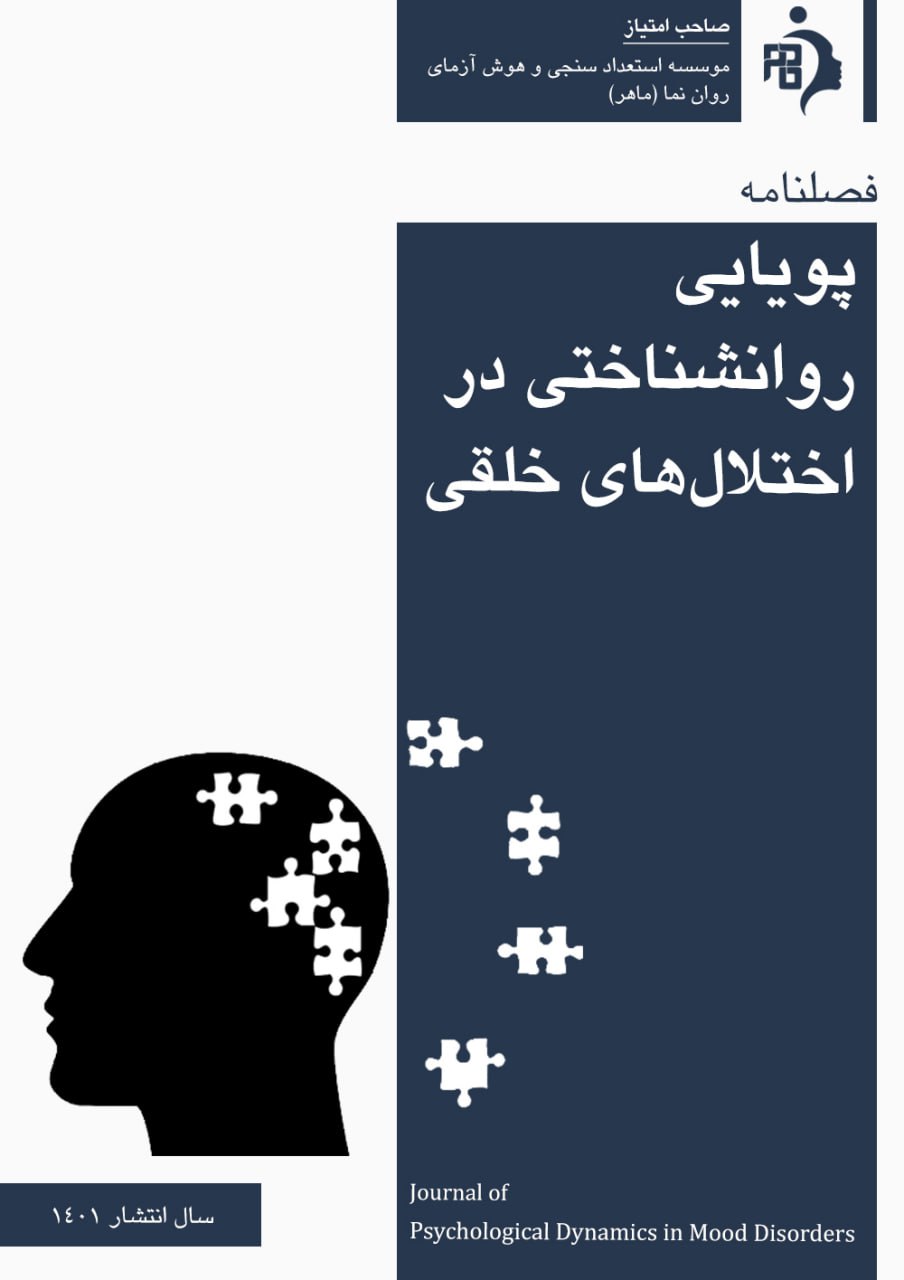روایی تشخیصی نسخه پنجم آزمون واژگان تصویری پیبادی در دانشآموزان با اختلال ویژه یادگیری
کلمات کلیدی:
روایی تشخیصی, آزمون واژگان تصویری پیبادی, نسخه پنجم, کودکان, اختلال ویژه یادگیریچکیده
هدف: هدف پژوهش حاضر بررسی روایی تشخیصی نسخه پنجم آزمون واژگان تصویری پیبادی (PPVT-5) در کودکان با اختلال ویژه یادگیری بود تا مشخص شود آیا این ابزار قادر به تمایز بین کودکان دارای اختلال ویژه یادگیری و کودکان عادی است. روششناسی: این پژوهش از نوع مطالعات روانسنجی و در چارچوب طرحهای روششناختی قرار داشت. جامعه آماری شامل کلیه کودکان با اختلال ویژه یادگیری تحت پوشش سازمان آموزش و پرورش استثنایی شهر تهران بود که به مراکز مشاوره آموزشی ارجاع داده شده بودند. با استفاده از روش نمونهگیری هدفمند، ۶۰ کودک دارای اختلال ویژه یادگیری و ۶۰ کودک عادی انتخاب شدند. ابزار مورد استفاده نسخه پنجم آزمون واژگان تصویری پیبادی بود. دادهها پس از نمرهگذاری با روشهای آماری فاصله اطمینان، ضریب حساسیت و وضوحگرایی تحلیل شدند تا میزان روایی تشخیصی آزمون در دو فرم «الف» و «ب» مشخص گردد. یافتهها: نتایج نشان داد تفاوت میانگینهای تجربی فرم «الف» (82.48) و فرم «ب» (83.39) با میانگین نظری (100) در سطح کمتر از یک انحراف معیار بود که بیانگر توانایی آزمون در تفکیک گروههای بالینی از عادی است. ضریب حساسیت برای فرم «الف» برابر با 0.85 و ضریب وضوحگرایی برابر با 0.78 بهدست آمد که نشانگر روایی تشخیصی مطلوب ابزار است. بنابراین هر دو فرم آزمون توانایی لازم برای شناسایی کودکان با اختلال ویژه یادگیری را دارا هستند. نتیجهگیری: یافتهها بیانگر آن است که نسخه پنجم آزمون واژگان تصویری پیبادی از روایی تشخیصی مناسب برای استفاده در ارزیابی و شناسایی کودکان با اختلال ویژه یادگیری برخوردار است و میتواند بهعنوان ابزاری معتبر در حوزه سنجش استثنایی مورد استفاده قرار گیرد.
دانلودها
مراجع
Alhamdan, A. A., Murphy, M., & Crewther, S. G. (2023). Visual Motor Reaction Times Predict Receptive and Expressive Language Development in Early School-Age Children. Brain Sciences, 13(6), 965. https://doi.org/10.3390/brainsci13060965
Arshad, T., Khan, M. A., Imtiaz, R., Ramzan, H., Tanveer, M., & Ashraf, A. (2025). Assessment of Vocabulary Development in Preschool Children Using Peabody Picture Vocabulary Test-4. Ijbr, 3(2), 174-179. https://doi.org/10.70749/ijbr.v3i2.629
Bell, N. L., Lassiter, K. S., Matthews, T. D., & Hutchinson, M. B. (2001). Comparison of the Peabody Picture Vocabulary Test-Third Edition and Wechsler Adult Intelligence Scale-Third Edition with university students. Journal of Clinical Psychology, 57(3), 417–422. https://doi.org/10.1002/jclp.1024
Besha, X. S., Spencer, R. J., & Bieliauskas, L. A. (2017). PPVT-I administration rules significantly shorten PPVT-III/IV administration. The International Journal of Neuroscience, 127(5), 412–416. https://doi.org/10.1080/00207454.2016.1186026
Bootsma, J., Campbell, F., McCauley, D., Hopmans, S., Grahovac, D., Cunningham, B. J., Phoenix, M., Camargo, O. K. d., Geytenbeek, J., & Gorter, J. W. (2023). Psychometric Properties of the English Language Version of the C-BiLLT Evaluated in Typically Developing Canadian Children. Journal of Pediatric Rehabilitation Medicine, 16(1), 71-81. https://doi.org/10.3233/prm-210101
Braga, A. C., Carreiro, L. R. R., Tafla, T. L., Ranalli, N. M. G., Silva, M. F. C. E., Honjo, R. S., Kim, C. A., & Teixeira, M. C. T. V. (2018). Cognitive and behavioral profile of Williams Syndrome toddlers. Codas, 30(4). https://doi.org/10.1590/2317-1782/20182017188
Cooper, C. (2019). Psychological Testing: Theory and Practice. Routledge. https://doi.org/10.4324/9781315391342
Costa Ribeiro, C., Abramides, D. V., Fuertes, M. G., Lopes dos Santos, P. N., & Lamônica, D. A. (2016). Receptive language and intellectual abilities in preterm children. Early human development, 99, 57–60. https://doi.org/10.1016/j.earlhumdev.2016.03.011
Di Fabio, R. P. (2013). Essentials of Rehabilitation Research: A Statistical Guide to Clinical Practice. F.A. Davis.
Dunn, D. M. (2019). Peabody Picture Vocabulary Test (5th ed.). Bloomington, MN: NCS Pearson
Dunn, L. M. (1953). College and University Programs for the Preparation of Teachers of Exceptional Children. https://eric.ed.gov/?id=ED543715
Dunn, L. M. (1957). The Effectiveness of Special Day Class Training Programs for Severely (Trainable) Mentally Retarded Children. https://catalog.hathitrust.org/Record/001974604
Dunn, L. M. (1958). Teachers of Children Who Are Mentally Retarded: Qualification and Preparation of Teachers of Exceptional Children. https://eric.ed.gov/?q=source%3A%22US+Department+of+Education%22&ff1=pubReports+-+Research&pg=19
Dunn, L. M. (1959). Peabody Picture Vocabulary Test. American Guidance Service
Dunn, L. M. (1963). Exceptional Children in the Schools. Holt, Rinehart and Winston. http://plib.azaruniv.ac.ir/Search/DocumentDetails/167580
Dunn, L. M. (1970). Peabody Individual Achievement Test Vol. I: Mathematics, Reading Recognition & Vol. II: Reading Comprehension, Spelling, General Information. American Guidance Service. https://journals.sagepub.com/doi/pdf/10.1177/002246697000400412
Dunn, L. M. (1976). Peabody Early Experiences Kit, Manual. American Guidance Services
Dunn, L. M., Chun, L. T., Crowell, D. C., Dunn, L. M., Alevy, L. G., & Yackel, E. R. (1976). Peabody Early Experiences Kit. American Guidance Service
Dunn, L. M., & Dunn, D. M. (2007a). Peabody Picture Vocabulary Test--Fourth Edition (PPVT-4). American Guidance Service
Dunn, L. M., & Dunn, D. M. (2007b). Peabody Picture Vocabulary Test (4th ed.). San Antonio, TX: Pearson Education, Inc. Guidance Service
Dunn, L. M., & Dunn, L. M. (1981). PPVT: Peabody Picture Vocabulary Test, Revised. American Guidance Service
Dunn, L. M., & Dunn, L. M. (1988). Bilingual Hispanic Children on the U.S. Mainland: A Review of Research on the Cognitive, Linguistic, and Scholastic Development. Dunn Educational Services. https://eric.ed.gov/?id=ED304274
Dunn, L. M., & Dunn, L. M. (1997). Peabody Picture Vocabulary Test (PPVT-III). American Guidance Service
Dunn, L. M., & Dunn, M. F. C. (1989). Peabody Individual Achievement Test - Revised (PIAT-R) Manual. American Guidance Service
Dunn, L. M., & Markwardt, F. C. (1970). Peabody Individual Achievement Test: Volumes I, II, and Manual (PIAT). American Guidance Service
Faramarzi, S., Kiani, M., & Lahijanian, Z. (2018). Development, validation, and reliability assessment of the Child Language Development Scale. Educational Measurement Quarterly, 8(31), 1–31. https://jem.atu.ac.ir/article_8984.html
Hashemi, S. A. (2017). Standardization of the second edition of the Reynolds Intellectual Assessment Scales (RIAS-2) among gifted school students (SAMPAD) Islamic Azad University, Science and Research Branch]. Tehran. https://journals.ut.ac.ir/article_67064.html
Kamkari, K., & Afrooz, G. A. (2019). Principles of Psychometrics and Intelligence Testing. University of Tehran Press.
Kapa, L. L., Meyers-Denman, C., Plante, E., & Doubleday, K. (2020). Predictors of Treatment Response for Preschool Children With Developmental Language Disorder. American Journal of Speech-Language Pathology, 29(4), 2082–2096. https://doi.org/10.1044/2020_AJSLP-19-00198
Lockwood, A. B., & Farmer, R. L. (2020). The Cognitive Assessment Course: Two Decades Later. Psychology in the Schools, 57, 265–283. https://doi.org/10.1002/pits.22298
Łuniewska, M., Krysztofiak, M., & Haman, E. (2024). Parental Report of Vocabulary in 3‐ to 6‐year‐old Polish Children: Reliable but Not Valid. International Journal of Language & Communication Disorders, 59(6), 2483-2496. https://doi.org/10.1111/1460-6984.13101
McLean, R. K., Tully, L. A., & Dadds, M. R. (2025). Reliability, Predictive Validity and Normative Data for the Pediatric Symptom Checklist-17 in a National Australian Sample. Australian & New Zealand Journal of Psychiatry, 59(8), 702-712. https://doi.org/10.1177/00048674251342952
Mekki, S., Nada, E., Ibraheem, O. A., & Gomaa, A. (2025). Development of Speech Intelligibility in Noise With Picture Identification (SPIN-PI) Test: A New Assessment Approach for Children With Auditory Processing Disorders. The Egyptian Journal of Otolaryngology, 41(1). https://doi.org/10.1186/s43163-025-00842-2
Pae, H. K., Greenberg, D., & Morris, R. D. (2012). Construct validity and measurement invariance of the Peabody Picture Vocabulary Test-III Form A. Language Assessment Quarterly, 9(2), 152–171. https://doi.org/10.1080/15434303.2011.613504
Pankratz, M., Morrison, A., & Plante, E. (2004). Difference in standard scores of adults on the Peabody Picture Vocabulary Test (Revised and Third Edition). Journal of Speech, Language, and Hearing Research. https://doi.org/10.1044/1092-4388(2004/054)
Pour-Etemad, H., Mousa Kazemi, M., Hooman, A., Sadeghi, M. S., & Hassanzadeh Tavakoli, M. R. (2011). Psychometric properties of the short form of the Persian Picture Vocabulary Test (PPVT-Persian). Advances in Cognitive Science. https://icssjournal.ir/article-1-358-fa.html
Quaranta, J., Darling, R., Chen, M. H., DeMartino, J., & Kozlowski, M. (2025). Development and Validation of the Pediatric Well-Being Picture Scale© Using a Mixed-Methods Research Design. Nursing Reports, 15(1), 29. https://doi.org/10.3390/nursrep15010029
Ruiter, L. d., Wen, P., & Chen, S. (2022). The Assessment of Chinese Children’s English Vocabulary—A Culturally Appropriate Receptive Vocabulary Test for Young Chinese Learners of English. Frontiers in psychology, 13. https://doi.org/10.3389/fpsyg.2022.769415
Wu, H., Liu, Q., Yu, B., Zhang, Y., Ren, D., Serdarevic, M., Liang, Z., Wang, Y., Chen, S., Zhang, K., & Chen, S. (2020). Psychometric properties of the Mandarin Clinical Evaluation of Language for Preschooler's Core Scale. Journal of Communication Disorders, 87. https://doi.org/10.1016/j.jcomdis.2020.106000
Zhou, J., Ding, Z., Zhang, M. X., Wei, X., An, W.-J., Zhu, Z., Guo, P., Qiu, L., Guo, Q., & Bai, Y. (2025). Developing and Validating Accurate Test Scale for Mandarin Vocabulary Comprehension Ability of Preschool Children. International Journal of Language & Communication Disorders, 60(6). https://doi.org/10.1111/1460-6984.70141
دانلود
چاپ شده
ارسال
بازنگری
پذیرش
شماره
نوع مقاله
مجوز
حق نشر 2025 سیدعلی هاشمی, کامبیز کامکاری, سعید حسن زاده (Author)

این پروژه تحت مجوز بین المللی Creative Commons Attribution-NonCommercial 4.0 می باشد.









